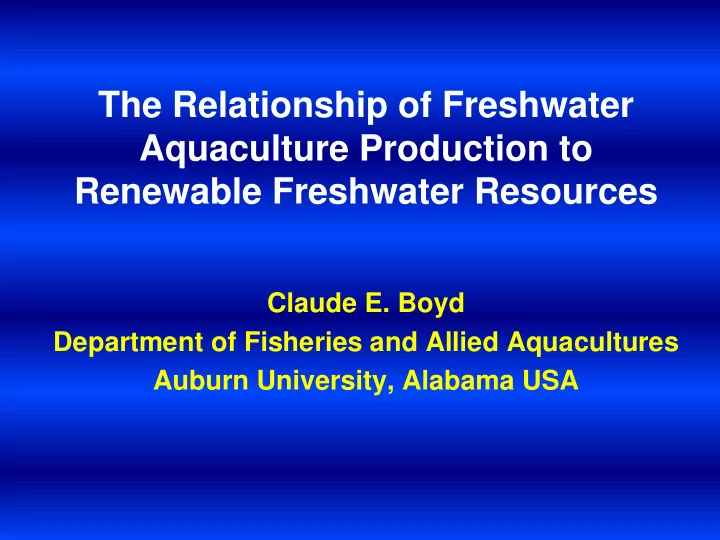

The Relationship of Freshwater Aquaculture Production to Renewable Freshwater Resources Claude E. Boyd Department of Fisheries and Allied Aquacultures Auburn University, Alabama USA
Current and projected world population by region. Population (millions) Increase Region 2010 2050 (%) Asia 4,169 5,231 20.3 Africa 1,033 1,998 93.4 Europe 733 691 -5.7 Latin America (South America, Mexico, and Caribbean) 589 729 23.7 Northern America (US and 352 448 27.2 Canada) Oceania (includes Australia) 36 51 41.6 World 6,909 9,150 32.4
World population and water footprint projections. 2008 2025 2050 Population (millions) 6,761 8,027 9,539 Water footprint (km 3 /yr) 8,400 9,980 11,190 *Accessible runoff (km 3 /yr) 12,500 ? ? About 30% of total runoff currently is accessible for human use.
Contribution of fisheries production to total world animal protein supply. Year (%) 1961 13.7 1992 14.9 1996 16.0 2003 14.6 2005 15.3
Aquaculture World capture
Summary of world fisheries production (2009). Production % total Component (million tonne) fisheries Inland fisheries Capture 10.1 7 Aquaculture 35.0 24 Marine fisheries Capture 1 79.9 55 Aquaculture 20.1 14 Total fisheries 145.1 100 1 Includes the fish meal fishery. If only fisheries products for direct human consumption are considered, aquaculture production approximately equals capture fisheries production.
Total food fish supply and freshwater aquaculture production by region in 2007. Million tonnes live weight Total food Freshwater fish aquaculture supply production Oceania 0.9 0.0014 Latin America and Caribbean 5.2 0.409 North America 8.2 0.333 Africa 8.2 0.332 Europe 16.2 0.454 Asia 74.5 30.0 China only 34.9 20.8 World 113.1 31.5
Estimated increase by 2050 in demand for edible fisheries products. Fisheries products consumed Population (million tonne) Year (billion) Total Capture Aquaculture 2009 6.91 117.8 62.7 55.1 2050 9.15 156 63.0 93.0
AP AFR = 100 RF where AFR = freshwater aquaculture production to renewable freshwater ratio (tonne/km 3 ); AP = freshwater aquaculture production (tonne/yr); RF = total renewable freshwater (km 3 /yr). The AFR also was estimated for continent and world levels.
Ratio of freshwater aquaculture production to renewable freshwater resources (AFR) in selected countries. AFR AFR (tonne/km 3 ) (tonne/km 3 ) Country Country Africa: North America: Ethiopia 0 United States 106 S. Africa 24 Zimbabwe 122 Latin America & Caribbean: Nigeria 500 Chile 10 Egypt 1,138 Colombia 22 Mexico 23 Asia: Brazil 26 Japan 93 Malaysia 165 Europe: Rep. of Korea 275 Russia 26 Thailand 1,260 Germany 197 India 1,752 France 219 Vietnam 1,987 Czech. Republic 1,275 China 7,344
Renewable freshwater, freshwater aquaculture production, and freshwater aquaculture production:renewable freshwater ratio (AFR) by region. Renewable Freshwater Continent freshwater aquaculture AFR (km 3 /yr) (tonne/km 3 ) (tonne/yr) Asia 12,461 30,015,550 2,409 (Asia without China) 9,649 9,234,485 957 Africa 3,950 332,113 84.1 North America 6,662 333,219 50.0 Europe 6,619 454,501 68.7 Latin America & Caribbean 13,161 408,692 31.1 Oceania 911 1,424 1.56 World 43,764 31,545,499 721 (World without China) 40,952 10,764,434 263
World freshwater aquaculture production to renewable freshwater ratio (AFR). Calculation AFR* (tonne/km 3 ) basis World average 721 World average without China 263 World average without Asia 48.9 * To obtain the projected 2050 world freshwater aquaculture production need, the world average AFR would increase to 1,259 tonne/km 3 .
Estimates of world freshwater aquaculture production at different freshwater aquaculture production to renewable freshwater ratios (AFR). Production Increase over Calculation (million 2009 basis tonne/yr) production (%) World average at China level 321 817 (AFR = 7,344) World average at Asia level 105 200 (AFR = 2,409) World average at Egypt level 49.8 42.3 (AFR = 1,138) World average at Asia without 41.9 19.7 China level (AFR = 957)
Concerns Expressed About Aquaculture • Destruction of mangrove, wetlands, and other sensitive aquatic habitat by aquaculture projects; • Conversion of agricultural land to ponds; • Water pollution resulting from pond effluents; • Excessive use of drugs, antibiotics, and other chemicalsor aquatic animal disease control; • Inefficient utilization of fish meal and other natural resources for fish and shrimp production; • Salinization of land and water by effluents, seepage, and sediment from brackishwater ponds;
Concerns Expressed About Aquaculture • Excessive use of ground water and other freshwater supplies for filling ponds; • Spread of aquatic animal diseases from culture of organisms to native populations; • Negative effects on biodiversity caused by escape of non-native species introduced for aquaculture, destruction of birds and other predators, and entrainment of aquatic organisms in pumps; and • Conflicts with other resource users and disruption of nearby communities.
Recommend
More recommend